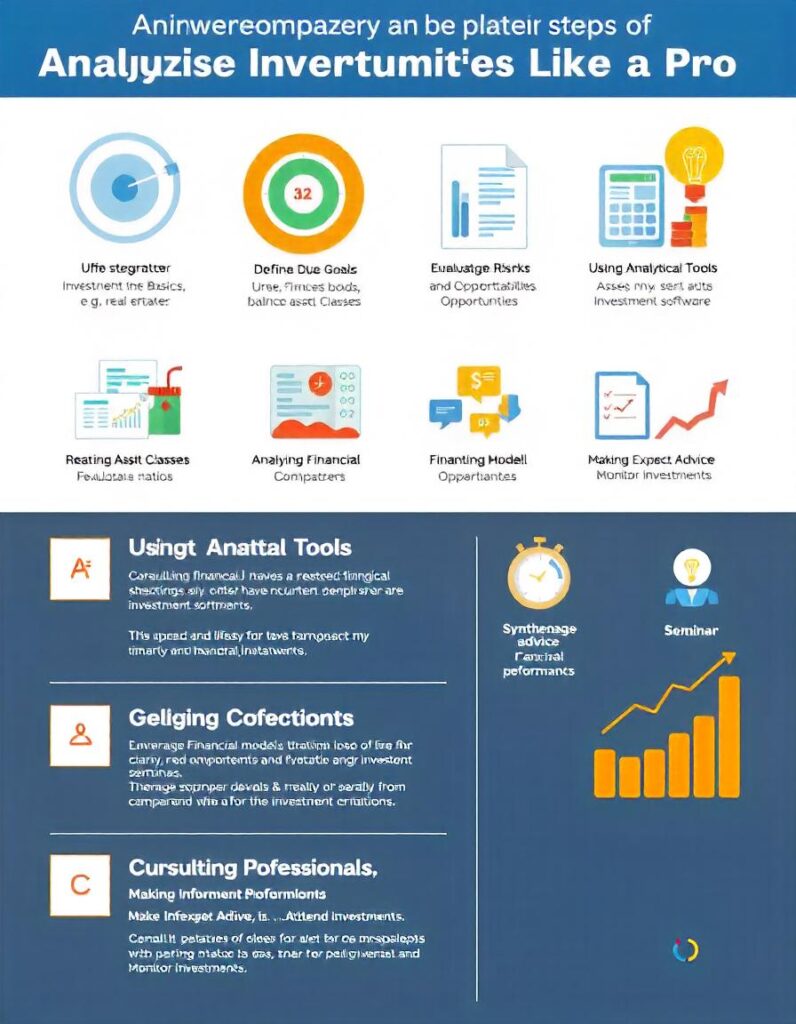Analyzing investment opportunities with a professional approach is crucial for achieving long-term financial success and optimizing returns. Whether you’re considering stocks, real estate, or startups, a systematic and thorough analysis helps identify the best opportunities and mitigate risks. This guide provides actionable insights on how to analyze investment opportunities like a pro, equipping you with the skills to make informed and strategic investment decisions.
1. Understand the Basics of Investment Analysis
1.1. Define Your Investment Goals
- Set Objectives: Clarify what you aim to achieve with your investments, such as capital appreciation, income generation, or diversification.
- Determine Time Horizon: Establish your investment time frame, whether short-term or long-term, to align with your goals and risk tolerance.
1.2. Research Different Asset Classes
- Stocks: Shares of companies that offer growth potential and dividends.
- Bonds: Debt securities that provide fixed interest payments and principal repayment.
- Real Estate: Physical properties that generate rental income and appreciate in value.
- Startups: Early-stage companies with high growth potential but higher risk.
2. Conduct Thorough Due Diligence
2.1. Analyze Financial Statements
- Income Statement: Assess revenue, expenses, and profit margins to evaluate a company’s profitability.
- Balance Sheet: Review assets, liabilities, and equity to understand financial stability.
- Cash Flow Statement: Examine cash inflows and outflows to gauge liquidity and operational efficiency.
2.2. Evaluate Key Financial Ratios
- Price-to-Earnings (P/E) Ratio: Measures the valuation of a stock relative to its earnings.
- Return on Equity (ROE): Indicates how effectively a company uses shareholder equity to generate profits.
- Debt-to-Equity Ratio: Shows the proportion of debt used to finance assets compared to equity.
2.3. Assess Industry and Market Trends
- Market Growth: Analyze the growth potential of the industry and its impact on investment returns.
- Competitive Landscape: Evaluate the competitive positioning and market share of companies within the industry.
- Regulatory Environment: Understand regulations and potential impacts on the industry and investments.
3. Evaluate Investment Risks and Opportunities
3.1. Identify Potential Risks
- Market Risk: Fluctuations in market prices that can affect the value of investments.
- Credit Risk: The possibility of default on debt securities by issuers.
- Operational Risk: Risks related to the operational aspects of a company or property.
3.2. Assess Investment Opportunities
- Growth Potential: Evaluate the potential for future growth and profitability.
- Valuation: Determine if the investment is fairly priced based on financial metrics and market conditions.
- Diversification: Consider how the investment fits within your overall portfolio to enhance diversification and reduce risk.
4. Use Advanced Analytical Tools
4.1. Leverage Financial Models
- Discounted Cash Flow (DCF) Analysis: Calculates the present value of future cash flows to estimate the intrinsic value of an investment.
- Comparable Company Analysis: Compares financial metrics with similar companies to gauge relative valuation.
- Risk-Return Analysis: Assesses the risk versus potential return of an investment using tools like the Sharpe Ratio.
4.2. Utilize Investment Software and Platforms
- Portfolio Management Tools: Track and analyze portfolio performance, asset allocation, and risk exposure.
- Market Research Platforms: Access detailed reports, news, and data on market trends and investment opportunities.
5. Consult with Professionals
5.1. Seek Expert Advice
- Financial Advisors: Consult with advisors who can provide personalized investment strategies and recommendations.
- Accountants and Tax Advisors: Obtain guidance on tax implications and optimize tax strategies for your investments.
5.2. Attend Industry Seminars and Workshops
- Educational Events: Participate in events to stay updated on market trends, investment strategies, and industry insights.
- Networking Opportunities: Connect with industry professionals and fellow investors to gain valuable perspectives and advice.
6. Make Informed Investment Decisions
6.1. Conduct a Comprehensive Analysis
- Synthesize Information: Combine insights from financial statements, market trends, and risk assessments to make informed decisions.
- Avoid Emotional Investing: Base decisions on data and analysis rather than emotions or market hype.
6.2. Monitor and Review Investments Regularly
- Track Performance: Continuously monitor the performance of your investments and adjust strategies as needed.
- Stay Informed: Keep up with market developments and adjust your portfolio to align with changing conditions and goals.

